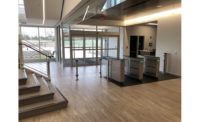Over the past few years, enterprise access control’s future has been shaped by supply chain issues, a pandemic and the steady march forward of technological innovation. Supply chain disruption led not only to product delays, but also to security integrators searching for alternatives to those products. The pandemic reimagined not only what a workplace looks like, but also where a workplace can be. And recent technological advancements have changed not only what access control can provide, but what end users expect. But the future looks far from dim for the industry.
“We have seen the access control market return to robust growth,” says Sanjeev Singh, vice president, products and program management, Johnson Controls, Milwaukee, Wis. “Technologies that were largely becoming legacy for most parts of the industry have been revived with the increasing adoption of biometrics, mobile, AI and cloud solutions.”
Enterprise access control is following the larger technological shift towards mobile and cloud-based solutions. These developments allow for an ease-of-use and reduction-of-cost, and when paired with analytic software, can offer insights into business operations that can benefit an organization.

Maureen Perrelli, chief revenue officer, Brivo, Bethesda, Md., says, “Remote, cloud-based management is now a must-have versus a nice-to-have. As a result, there is demonstrable customer demand and need for better access control experiences — intelligent solutions that integrate with an existing technology ecosystem and provide real-time data so they can optimize the use of their assets.”
And end users are aware of what technology is available to them. “End users are getting much smarter and more capable from a system perspective and a software perspective,” says John Joyce, director enterprise markets – East, Genetec, Montreal.
On Premises No Longer Necessary
Today, the software, data storage and management of an access control solution doesn’t need to be handled on site by a technician. Cloud technology has been advanced enough to allow for these services for a while, but the technology has now proven itself enough that larger end users are beginning to open up to it.
“The other big change is the willingness of customers to adopt cloud-based solutions versus on premise solutions,” says Brad McMullen, president, 3xLOGIC, PACOM, SONITROL, Fishers, Ind. “Cloud solutions provide customers the ability to add/remove services, update firmware and ensure the latest cyber hygiene without having to send a technician onsite. With the cloud, many of these items can be done remotely.”
The cloud also offers the benefit of increased cybersecurity. Previously, on premises solutions would often fall behind on firmware, hardware and software updates, but these issues have decreased with the ability to install these updates remotely.
“A lot of customers had invested in an extra control system or security system, just kind of let it do what it does, [and] had it age out, not really keeping up to date with firmware and new versions of hardware,” Joyce says. “Not keeping their software versions up to date resulted in potential susceptibilities for a cybersecurity breach. So that certainly changed. You're seeing physical security teams, facilities managers, IT working much closer together to make sure that they’re limiting any kind of potential issues they could have with cybersecurity breaches.”
Putting Data to Work
Everyone may be storing their data in the cloud, but what good is data collected? Data becomes most valuable when you can make it tell a story. Analytics and AI advancements have brought the ability for that data to become useful to end users by relaying who goes where, when and how.
“AI is at the core of many of today’s cloud-based access control systems,” Perrelli says. “AI allows these solutions to predict and analyze trends, for example, identifying behaviors that are out of the ordinary or suspicious. At the end of the day, customers want smart systems that make their lives easier and safer, which is what many of these new technologies offer.”
“End users are getting much smarter and more capable from a system perspective and a software perspective.”
— John Joyce, Genetec
But these analytics don’t just provide human data, they can also provide efficiency insights to large organizations.
McMullen says, “Many of these platforms allow for IoT sensors to be connected and the data collected and analyzed to provide insights into energy consumption, occupancy management, air quality, traffic patterns and changes in environments. Taking this data, analyzing it and providing recommendations based on the inputs is all possible.”

Analytics can bring together all of this data to help an organization evaluate their operations and efficiency, in addition to protecting their members. Optimization is the goal here, especially in the current economic environment. With labor storages and supply chain stress, this data can prove invaluable.
“We are also seeing end users depend more on their security product vendor and integrators for optimizing their day-to-day operations,” Singh says. “Labor shortages, financial challenges and ongoing socio-economic uncertainties have led end users to demand more from their vendors and service providers. This has brought vendors like us closer to end users, allowing us to become their trusted source to manage through such uncertainties.”
Singh continues, “This will help improve security operations, optimize cost of operation, and improve end user experience with the use of less intrusive methods of monitoring and situation awareness. Security intelligence enabled by AI application to access control is all about leveraging underlying data from access control and other connected systems and providing customers with tools to improve operational efficiency and time to response for events that matter. We are seeing increasing interest from end users, especially the enterprise segment, for solutions such as this to help them streamline their security operations and make their workplace safer.”
Identification on the Go
As the world goes mobile, further embracing the smartphone as the solution to more and more of our needs, mobile credentials can provide quite a few benefits to the enterprise access control industry. Mobile access can provide convenience, especially as the average end user has become much more comfortable with smartphone technology. End users have also become much more open to the smartphone handling their sensitive data, like their credit card information and their personal or professional identification.
“Mobile credentials improve the user experience, reduce costs and even provide enhanced security with biometric authentication,” says Jody Ross, vice president of sales, AMAG Technology, Hawthorne, Calif. “Mobile credentials also allow for the remote administration of badging and instant control over access to a building. Additionally, mobile credentials can be remotely revoked if lost or stolen.”
Ross also says, “Mobile credentials can be more cost-effective than traditional access control methods, as they eliminate the need for physical key cards or fobs. Additionally, they can reduce administrative costs by enabling remote credential management and eliminating the need for on-site maintenance. Mobile eliminates the need for physical keys or access cards, which can be lost or forgotten. Users simply use their smartphones to access secured areas.”
As Ross explains, another benefit of mobile access is the use of biometric identification in smartphones. To access sensitive data — like that stored in the Apple wallet — the smartphone will ask the user for Face ID (facial recognition) or Touch ID (fingerprint recognition).
“They also provide an added layer of security due to the biometric used within the phone such as facial recognition or fingerprint scanning,” Ross continues. “This ensures that only authorized individuals are granted access.”
Securing the Cloud
The adoption of mobile access and cloud-based solutions has raised some cybersecurity concerns, but it can be much more secure than a collection of disparate solutions for each type of access. “With cloud access from anywhere, an administrator can instantly create, modify or terminate entry credentials for a staff member, contractor or others who need access to a floor, office, conference room, network or computer,” Perrelli says. “That solution is far superior to cobbling a patchwork of point solutions, which typically leaves gaping holes available to hackers and criminals. Today, customers demand cyber-hardened systems.”

“Integrators stand to lose if they were primarily associated with transactional installation services. They can be relevant and retain their customers for the long term if they evolve to participate in the subscription-based software and support services in the future.”
— Sanjeev Singh, Johnson Controls
Perrelli adds, “Good physical security doesn’t exist without good cybersecurity. Chief security officers seek to unify security solutions and gain visibility across the enterprise within cyber and physical realms. Unsecure access management hardware or systems can be compromised and used as a foothold to hack into wider corporate networks with potentially catastrophic results.”
Genetec’s Joyce says physical security teams, facility managers and IT are working to limit potential cybersecurity breaches. “They have to work on hardening their devices, hardening their systems overall, developing product replacement strategy.”
Analytics can help with this, Ross says. “In regards to cybersecurity, analyzing network traffic, user behavior and other data, analytics can help identify potential threats and vulnerabilities in real time,” she says. “This can help security teams quickly respond to cyberattacks and prevent data breaches.”
Looking Ahead
Enterprise end users are looking for solutions to what Perrelli calls a “patchwork of point solutions.”
On the critical infrastructure front, Jerry Burhans, managing director of Assa Abloy Global Solutions – Critical Infrastructure, Stockholm, Sweden, offers a similar sentiment. “The enterprise end user is not satisfied with disparate systems and they are demanding open ecosystems. I recommend being mindful of collaborations between brands and trust those companies that support a true open ecosystem. You’ll want to know the difference between surface level interface, deep integration, open ecosystems and a marketing partnership.”
As the enterprise access control industry is reshaped by evolving technology and end user expectations, it is creating great opportunities for security integrators to meet end users’ needs. The mobile access, cloud-based and analytic solutions and services available to end users provide them with cost-reduction, increased convenience and increased security. And, according to Singh, there’s increased opportunity for retention and relevance in the industry.
“The disruptive nature of the cloud and as-a-service business model is creating new challenges for integrators as they look to protect their interest with participation in the RMR based revenue stream,” Singh says. “Integrators stand to lose if they were primarily associated with transactional installation services. They can be relevant and retain their customers for the long term if they evolve to participate in the subscription-based software and support services in the future.”










